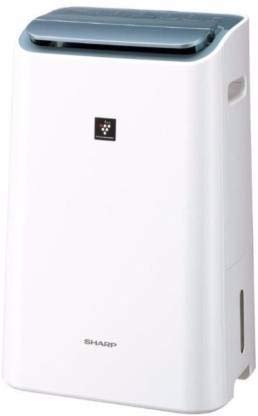Out of the many dehumidifiers available in the market, not every one is capable of delivering an outstanding performance. So it becomes important for us to select dehumidifiers not only according to their low price but also by checking their capabilities. We have tested each and everyone which are listed below and found out that they perform well under different circumstances.
When it’s humid, unfortunately, that stickiness doesn’t always stay outside. It can creep into your home and make already wet spaces like the bathroom and laundry room even damper. That humidity can do damage to your home, like rusting pipes or rotting wood, but it also provides an ideal environment for mold to grow.
“When the humidity is in the 50% range and higher, there’s enough moisture in the air that you’re going to have problems in your home,” said Dr. Joseph Lstiburek, Ph.D., building science engineer at Building Science Consulting . “You need to control humidity levels if you want to reduce mold growth.”
Humidity itself isn’t bad; in fact it’s necessary because humans need humid air in order to breathe properly—the optimal relative humidity indoors ranges between 30-50 percent. But when excessive water stays inside your walls or windows instead of evaporating, it can lead to mold growth and other problems.
“When the humidity is in the 50% range and higher, there’s enough moisture in the air that you’re going to have problems in your home,” said Dr. Joseph Lstiburek, Ph.D., building science engineer at Building Science Consulting . “You need to control humidity levels if you want to reduce mold growth.”
Humidity itself isn’t bad; in fact it’s necessary because humans need humid air in order to breathe properly—the optimal relative humidity indoors ranges between 30-50 percent. But when excessive water stays inside your walls or windows instead of evaporating, it can lead to mold growth and other problems. What do you do?
For most, a home between 30-50% humidity is ideal (higher in the summer and lower in the winter). When humidity creeps above 50%, the space can become a breeding ground for mold, mildew, dust mites, and other critters.
Our team has made a list of 5 best dehumidifiers by comparing these products on parameters such as area coverage capacity, water extraction capacity, noise, power consumption etc so you don’t have to read complete review about each one separately. Let’s start with them:
High Humidity 50-Pint Capacity Dehumidifier
The Eureka 735ZBS is a top-performing dehumidifier. It has simple, useful features that helped it win. A digital readout displays the present humidity, and the circular window informs you when the bucket should be changed (you can also connect a hose for constant drainage). The cord coils around hooks on the back for convenient storage, and the side handles and wheels make transportation easy.
Low Humidity 22-Pint Capacity Dehumidifier
The Dr. Cool dehumidifier (22 pints) has the same outstanding characteristics as our top overall pick, such on as portability, simple storage (with hooks for wrapping the cord), and a tank that you can view through the window. It’s light and compact, making it an excellent choice for limited areas or areas that aren’t overly damp.
PuriCare 50-Pint Clear Bucket Dehumidifier
The LG Cleaning Center is a well-designed and thought-through solution. The transparent bucket lets you keep track of how much water has come into the container (with an alert when it’s full) while also having a splash guard with a huge handle to make dumping easier. You may attach a hose to the rear for continual drainage, and it rests every 23 hours to help avoid overheating.
50-Pint Dehumidifier with Built-In Pump
This GE model has a built-in pump, allowing you to drain a window or a raised sink via a hose. Because it can remove moisture from spaces up to 1,500 square feet in size, this tough choice is perfect for use in basements or in modest homes that require more extensive dehumidification. If you don’t want to use the hose, it features a full tank warning and will automatically switch off if you can’t empty it within the designated time limit.
PuriCare 50-Pint Pump and Wi-Fi Dehumidifier
This dehumidifier has a 12-hour timer and uses dehumidification to maintain the desired humidity levels in the space. The drain pump may be connected to a hose for continuous draining. When the bucket is nearly full, an alert will appear on the clear displays, and the auto-shutoff feature will prevent an overflow. It’s transportable thanks to four wheels, as well as a washable filter and clear displays. The LG SmartThinQ app allows you to turn the dehumidifier on and off, check its bucket capacity, and receive other alerts from your phone or through Alexa commands when you’re not home or away. Although it’s marketed as a 50-pint dehumidifier, the changes in testing standards equates to roughly a 30-pint device tested now.
Top 5 College Looks Inspired From TikTok Star Charli D’amelio
What kind of dehumidifier do I need?
If humidity is an issue throughout the entire house, a whole-home system may be the best option.
If your moisture concerns are limited to a certain area of the home or are only seasonal, a portable residential unit is your best option. Smaller dehumidifiers tend to be less expensive and easier to transport, but they may not be as efficient when operating at full speed.
It’s safer to go with a larger machine than a smaller one and run it less frequently.
How do I pick the right size dehumidifier?
The size of your room and the amount of moisture in it will determine how big or little a dehumidifier needs to be. Dehumidifiers are measured in pints of moisture per day, based on the amount of water they can remove: The bigger and wetter your space is, the more powerful your unit will have to be. A 70-pint dehumidifier, for example, may satisfy a very damp 700 square feet or a somewhat moist 1,200 square feet. Keep in mind that if the space is cooler (for example, a basement), the dehumidifier will remove less moisture because colder air contains less moisture than warmer air.
Small: Removes 20-25 pints of moisture at 65°F, or 30-40 pints at 80°F (about 400-600+ square feet)
Medium: Removes 30-35 pints of moisture at 65°F, or 50-60 pints at 80°F (about 800-1,000+ square feet)
Large: Removes 40-55 pints of moisture at 65°F, or 70-90 pints at 80°F (about 1,200-1,500+ square feet)
What features matter when it comes to buying a dehumidifier?
Hose connection. If you’ll be using a large-capacity dehumidifier for a particularly damp project, you might want to look for one with a hose connection so that you don’t have to empty it manually. If you can’t find one with a hose, search for one with a pump and send water up to a sink or window. Alternatively, you’ll have to physically (and constantly) dump the collected water if none of these options are available.
A filter indicator reminds you when to clean your air filter.
An auto-humidistat can sense the moisture in the air and turn off automatically once the desired level is reached.
Low temperature setting and/or auto-defrost is helpful if the dehumidifier will be in a cool place, since it ensures the unit can properly operate in cooler temps.
How do I make sure my dehumidifier runs efficiently?
Make sure there is enough of a breeze coming in and out of the device. Some units have vents on top, allowing them to be placed against a wall. Others have vents on the sides, so they shouldn’t be pushed up against walls or furnishings.
Clean the air filter on a regular basis. If the air conditioner is unclean, it won’t perform as well. Make certain you clean it at least once a week.
When cleaning or emptying the container, be sure to turn off the machine.
Top 10 Quotes From Netflix’s Money Heist that motivates you


